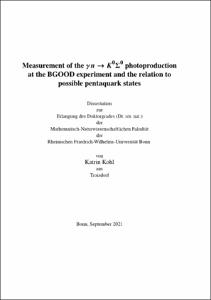Kohl, Katrin: Measurement of the γn→K0Σ0 photoproduction at the BGOOD experiment and the relation to possible pentaquark states. - Bonn, 2022. - Dissertation, Rheinische Friedrich-Wilhelms-Universität Bonn.
Online-Ausgabe in bonndoc: https://nbn-resolving.org/urn:nbn:de:hbz:5-66209
Online-Ausgabe in bonndoc: https://nbn-resolving.org/urn:nbn:de:hbz:5-66209
@phdthesis{handle:20.500.11811/9736,
urn: https://nbn-resolving.org/urn:nbn:de:hbz:5-66209,
author = {{Katrin Kohl}},
title = {Measurement of the γn→K0Σ0 photoproduction at the BGOOD experiment and the relation to possible pentaquark states},
school = {Rheinische Friedrich-Wilhelms-Universität Bonn},
year = 2022,
month = apr,
note = {Hadrons are particles consisting of quarks bound by the strong force. Ground states and lower lying excitations can be described successfully as mesons consisting of quark-antiquark pairs and baryons consisting of three quarks. At higher excitation energies however, discrepancies between the theoretical description and the experimental observations become obvious. Multi-quark structures consisting of qqqq or qqqqq could explain the observations. These could be realized as compact colour bound structures or meson-meson or meson-baryon type systems in analogy to the binding of nucleons in a nucleus. Experimental results have confirmed tetra-quark and penta-quark objects to exist with a minimal quark content of uucc (X(3872) discovered at Belle) and uudcc (PC states discovered at LHCb) respectively.
Also in the uds-quark sector interesting observations have been made. A cusp in the cross section of the reaction γp→K0Σ+ could be explained by the same model that predicted the abovementioned penta-quark states at LHCb. The structure is described as an interference of intermediate K*Λ and K*Σ states, amplified by the presence of a vector meson-baryon dynamically generated K*Σ resonance, the N*(2030). This resonance is the strange quark analogue to the PC states in the charm quark sector. From this model a prediction is made for the reaction on the neutron γn→K0Σ0. The destructive interference leading to a cusp in γp→K0Σ+ becomes constructive and produces a peak in γn→K0Σ 0. An observation of this peak would be a smoking gun signal for meson-baryon type resonances to exist not only in the charm quark sector, but also in the strange sector.
In this thesis the differential cross section of γn→K0Σ0 is measured at BGOOD at ELSA from threshold to a beam energy of 2600 MeV . A peak is observed at 1750 MeV in the angular range0.2<θK CM<0.5 . The available statistics prevent a final claim of evidence, also the structure originating from “conventional” resonances can not be strictly ruled out. However, shape and position are consistent with the model of the vector-meson baryon dynamically generated state. The enhancement being real is further supported by findings on the photoproduction of K+Λ(1405). A structure in the cross section is described by a triangle singularity fed by the same N*(2030) K*Σ type resonance, indicating that also the enhancement observed in the γn→K0Σ0 cross section is caused by this predicted resonance.},
url = {https://hdl.handle.net/20.500.11811/9736}
}
urn: https://nbn-resolving.org/urn:nbn:de:hbz:5-66209,
author = {{Katrin Kohl}},
title = {Measurement of the γn→K0Σ0 photoproduction at the BGOOD experiment and the relation to possible pentaquark states},
school = {Rheinische Friedrich-Wilhelms-Universität Bonn},
year = 2022,
month = apr,
note = {Hadrons are particles consisting of quarks bound by the strong force. Ground states and lower lying excitations can be described successfully as mesons consisting of quark-antiquark pairs and baryons consisting of three quarks. At higher excitation energies however, discrepancies between the theoretical description and the experimental observations become obvious. Multi-quark structures consisting of qqqq or qqqqq could explain the observations. These could be realized as compact colour bound structures or meson-meson or meson-baryon type systems in analogy to the binding of nucleons in a nucleus. Experimental results have confirmed tetra-quark and penta-quark objects to exist with a minimal quark content of uucc (X(3872) discovered at Belle) and uudcc (PC states discovered at LHCb) respectively.
Also in the uds-quark sector interesting observations have been made. A cusp in the cross section of the reaction γp→K0Σ+ could be explained by the same model that predicted the abovementioned penta-quark states at LHCb. The structure is described as an interference of intermediate K*Λ and K*Σ states, amplified by the presence of a vector meson-baryon dynamically generated K*Σ resonance, the N*(2030). This resonance is the strange quark analogue to the PC states in the charm quark sector. From this model a prediction is made for the reaction on the neutron γn→K0Σ0. The destructive interference leading to a cusp in γp→K0Σ+ becomes constructive and produces a peak in γn→K0Σ 0. An observation of this peak would be a smoking gun signal for meson-baryon type resonances to exist not only in the charm quark sector, but also in the strange sector.
In this thesis the differential cross section of γn→K0Σ0 is measured at BGOOD at ELSA from threshold to a beam energy of 2600 MeV . A peak is observed at 1750 MeV in the angular range
url = {https://hdl.handle.net/20.500.11811/9736}
}






